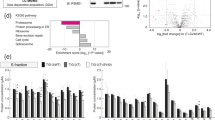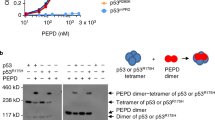Abstract
A key step in activation of the p53 tumor suppressor is its transport into the nucleus; however, despite intensive study of p53, the regulation of its subcellular localization is still poorly understood. Here we examined the p53 nuclear importation using a series of mutant cell lines that were resistant to the growth inhibitory effects of temperature-sensitive murine p53 (tsp53). Examination of the p53 subcellular localization in these cell lines showed that the protein was cytoplasmic in most of them. Using a digitonin-permeabilized cell in vitro nuclear import system, we show that cytosols from these cell lines do not support nuclear translocation of a p53 nuclear localization signal (NLS)-containing substrate protein, but promote nuclear localization of a SV40TAgNLS-containing substrate. Complementation assays and use of the mutant cells themselves in the in vitro assays demonstrate that both soluble and insoluble protein components are involved in p53 nuclear import. Collectively, our results suggest that there is a p53 NLS-selective nuclear import pathway and that both soluble and insoluble proteins are involved in its function.
This is a preview of subscription content, access via your institution
Access options
Subscribe to this journal
Receive 50 print issues and online access
$259.00 per year
only $5.18 per issue
Buy this article
- Purchase on Springer Link
- Instant access to full article PDF
Prices may be subject to local taxes which are calculated during checkout






Similar content being viewed by others
References
Adam SA, Marr RS, Gerace L . (1990). Nuclear protein import in permeabilized mammalian cells requires soluble cytoplasmic factors. J Cell Biol 111: 807–816.
Gaitonde SV, Riley JR, Qiao D, Martinez JD . (2000). Conformational phenotype of p53 is linked to nuclear translocation. Oncogene 19: 4042–4049.
Goldman SC, Chen CY, Lansing TJ, Gilmer TM, Kastan MB . (1996). The p53 signal transduction pathway is intact in human neuroblastoma despite cytoplasmic localization. Am J Pathol 148: 1381–1385.
Gorlich D, Mattaj IW . (1996). Nucleocytoplasmic transport. Science 271: 1513–1518.
Levine AJ . (1997). p53, the cellular gatekeeper for growth and division. Cell 88: 323–331.
Liang SH, Clarke MF . (1999). A bipartite nuclear localization signal is required for p53 nuclear import regulated by a carboxyl-terminal domain. J Biol Chem 274: 32699–32703.
Martinez J, Georgoff I, Martinez J, Levine AJ . (1991). Cellular localization and cell cycle regulation by a temperature-sensitive p53 protein. Genes Dev 5: 151–159.
Middeler G, Zerf K, Jenovai S, Thulig A, Tschodrich-Rotter M, Kubitscheck U et al. (1997). The tumor suppressor p53 is subject to both nuclear import and export, and both are fast, energy-dependent and lectin-inhibited. Oncogene 14: 1407–1417.
Nishi K, Yoshida M, Fujiwara D, Nishikawa M, Horinouchi S, Beppu T . (1994). Leptomycin B targets a regulatory cascade of crm1, a fission yeast nuclear protein, involved in control of higher order chromosome structure and gene expression. J Biol Chem 269: 6320–6324.
Shaulsky G, Goldfinger N, Ben-Ze'ev A, Rotter V . (1990). Nuclear accumulation of p53 protein is mediated by several nuclear localization signals and plays a role in tumorigenesis. Mol Cell Biol 10: 6565–6577.
Tran EJ, Wente SR . (2006). Dynamic nuclear pore complexes: life on the edge. Cell 125: 1041–1053.
Acknowledgements
We thank Dr Minoru Yoshida for providing leptomycin B and Dr Stephen A Adam for the pGST-SV40TAgNLS-EGFP plasmid. This work was supported by the National Institutes of Health Grant CA090776 to JDM.
Author information
Authors and Affiliations
Corresponding author
Rights and permissions
About this article
Cite this article
Li, Q., Falsey, R., Gaitonde, S. et al. Genetic analysis of p53 nuclear importation. Oncogene 26, 7885–7893 (2007). https://doi.org/10.1038/sj.onc.1210597
Received:
Revised:
Accepted:
Published:
Issue Date:
DOI: https://doi.org/10.1038/sj.onc.1210597
Keywords
This article is cited by
-
Inhibition of Kpnβ1 mediated nuclear import enhances cisplatin chemosensitivity in cervical cancer
BMC Cancer (2021)
-
TIP30 Directly Binds p53 Tumor Suppressor Protein In Vitro
Molecules and Cells (2012)
-
Impaired p53 binding to importin: a novel mechanism of cytoplasmic sequestration identified in oxaliplatin-resistant cells
Oncogene (2009)
-
A high-content chemical screen identifies ellipticine as a modulator of p53 nuclear localization
Apoptosis (2008)



